A population study of 43 exoplanets orbiting M-dwarf stars used both the transit method and radial velocity method to find the densities of the worlds and a surprising pattern emerged. The planets are less dense than expected, suggesting they are not purely rock but half-rock and maybe half-water. Plus, star factories in the Milky Way, glaciers on ancient Mars, and This Week in Space History.
Podcast
Show Notes
Galaxies, including the Milky Way, form stars from the center out
- MPIA press release
- “Detection of an excess of young stars in the Galactic Centre Sagittarius B1 region,” Francisco Nogueras-Lara, Rainer Schödel, and Nadine Neumayer, 2022 August 25, Nature Astronomy
The bar at the center of the galaxy was built by thirsty star formation
- NAOJ press release
- “Age distribution of stars in boxy/peanut/X-shaped bulges formed without bar buckling,” Junichi Baba, Daisuke Kawata, and Ralph Schönrich, 2022 March 8, Monthly Notices of the Royal Astronomical Society
Stars caught spiraling in Small Magellanic Cloud
- NASA press release
- “The Internal Line-of-Sight Kinematics of NGC 346: The Rotation of the Core Region,” Peter Zeidler, Elena Sabbi, and Antonella Nota, 2022 September 8, The Astrophysical Journal
Martian glaciers moved very, very slowly
- AGU press release
- “Valley Networks and the Record of Glaciation on Ancient Mars,” A. Grau Galofre, K. X. Whipple, P. R. Christensen, and S. J. Conway, 2022 July 25, Geophysical Research Letters
Water worlds may hide water underground
- University of Chicago press release
- “Density, not radius, separates rocky and water-rich small planets orbiting M dwarf stars,” Rafael Luque and Enric Palle, 2022 September 8, Science
‘Planetary heists’ steal gas giants from young systems
- The University of Sheffield press release
- “Making BEASTies: dynamical formation of planetary systems around massive stars,” Richard J Parker and Emma C Daffern-Powell, 2022 September 7, Monthly Notices of the Royal Astronomical Society
This Week in Space History: Famous Space Speeches
- Address at Rice Univesity on the Nation’s Space Effort (JFK Presidential Library and Museum)
- US to Return Astronauts to the Moon by 2024, VP Pence Says (Space.com)
Transcript
At a very fundamental level, astronomy captivates so many people because it tries to answer fundamental questions about how we got here, and every new discovery unlocks a new “but how…”. Scientists really are just grownups who never outgrew the five years old’s habit of asking questions.
The real thing that differentiates five-year-olds and scientists? We have to find the answers for ourselves, combining observations, maths, and a whole lot of computational modeling.
In today’s episode, we follow a variety of teams of researchers as they track down the fundamental questions of “but how did stars shape galaxies in the early universe?” and “but how did those stars form such varied structures?” and “but how did those stars then generate rocky and wet worlds to form?”
We’ll cover all of this and more, right here on the Daily Space.
I am your host Dr. Pamela Gay.
And we’re here to put science in your brain.
Just like it can be hard to fully understand a city’s skyline from the sidewalk view in the theatre district, it is hard to understand our galaxy’s structure from our perspective about halfway out from the galactic center.
We do the best we can, and we spend a lot of time looking at other galaxies and hoping that what we learn about them also applies to us. For many years, astronomers have been aware that distant young galaxies first form stars in their core, and that star formation moves outward. Confirming if that happened in our Milky Way has been a challenge both because there is gas and dust blocking a lot of our view of the galactic core and because when we can peer in, the galaxies are so packed together that they are hard to study individually.
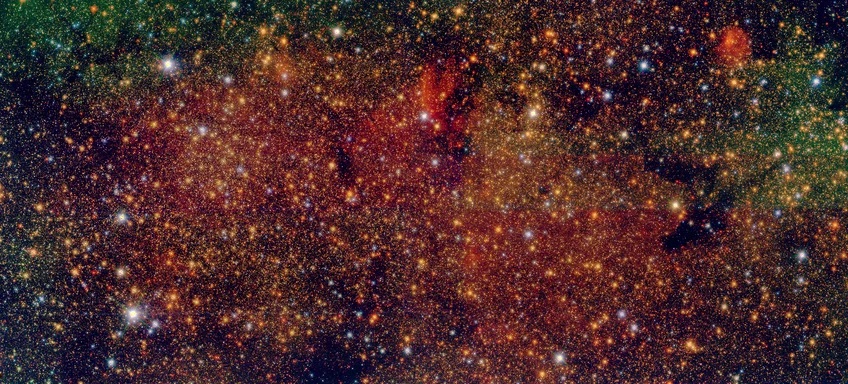
Now, using high-resolution infrared images taken with the Very Large Telescope (VLT) in Chile, researchers have been able to peer through the gas and dust and resolve individual stars. Infrared light isn’t scattered off dust and gas the same way the colors of light we see with our eyes are scattered. Just like a soldier can see people through plaster walls with infrared glasses, telescopes can see stars through walls of gas. And the VLT is not just any telescope; it is actually a suite of 4-8 meter telescopes with numerous one-meter helper scopes that can combine their light to obtain the highest currently possible resolution images. In this case, they were able to make out objects just two-tenths the width of a hair held at arm’s length.
In new research published in Nature Astronomy, researchers led by Francisco Nogueras-Lara use 150 VLT images to map out three million stars in the Milky Way’s central region. Previously, we’d only had data for a few stars in this region.
In going from data on a few stars to a few million stars, researchers were able to determine stellar ages as a function of distance from the galactic core in a statistically significant way. While there are young stars and old stars everywhere, the average age was found to change, with the innermost stars forming more than seven billion years ago. They also found that while modern stars away from the galactic center are often formed in massive clusters, the stars in the galactic center formed in small associations that quickly fell apart, leaving the core with a mess of elder stars with no clear groupings remaining.
According to Nogueras-Lara: Our study represents a big step forward in finding the young stars in the Galactic Center. The young stars we found have a total mass of more than 400,000 solar masses. That is nearly ten times higher than the combined mass of the two massive star clusters that were previously known in the central region.
Now that we’ve tested our theory that stars formed from the inside out, we may be ready to start asking just how did those stars end up forming the peanut-shaped distribution of stars that we see?
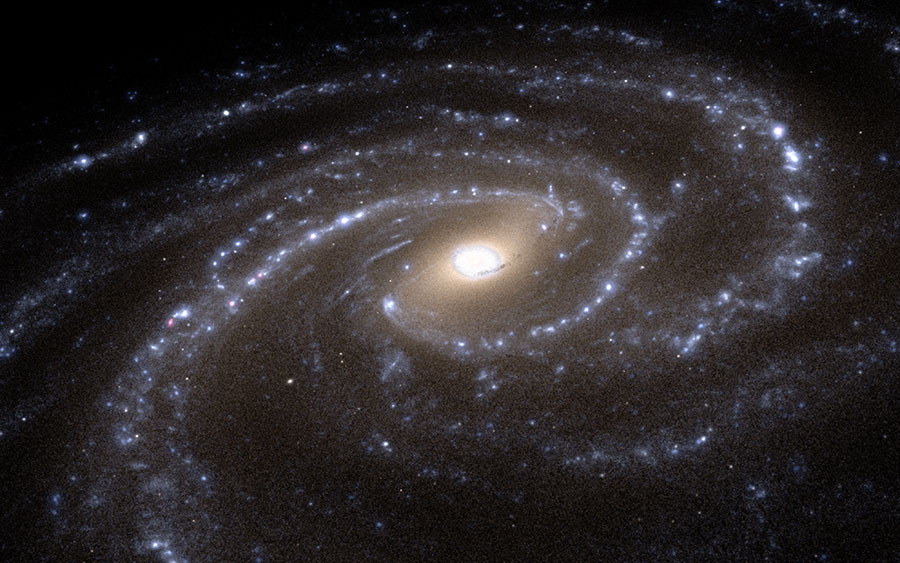
As near as we can tell, our galaxy is a barred spiral with two bars of gas and stars extending out from a peanut-shaped central bulge. New models, published in the Monthly Notices of the Royal Astronomical Society and led by Junichi Baba, indicate that the rapid flow of gas along these bars drove star formation in the center, while gravitational interactions of existing stars with that bar tossed those stars into their odd, peanut-shape forming distribution. The simulation even offers observational tests: If this model is correct, stars in the peanut-y bulge should be older than the stars in the central area that are forming from gas flowing down the bar. The team hopes that analysis of data from the Gaia space telescope will allow this check to be made. When their results are known, we’ll bring them to you here on the Daily Space.
One of our joys and frustrations as researchers comes from the universe’s habit of finding multiple ways to accomplish the same thing. Did galaxies form in one large collapse of stuff into one large galaxy or through the build-up of lots of small stuff into a large galaxy? Honestly, it depends on the galaxy.

As we look about and work to understand star formation here and beyond, we see a variety of behaviors. In another new study, this time in the Astronomical Journal, researchers led by Peter Zeidler used the Hubble Space Telescope to study how stars form in the outskirts of a massive cluster in the nearby Small Magellanic Cloud and then spiral in toward the center of the cluster. This pattern of formation and migration is dictated by factors like angular momentum, friction, and good ol’ gravitational interactions. Understanding the physics is actually straightforward. What was hard was getting this data. Their Hubble data was taken over eleven years and allows the stars changing positions in the sky to be measured. Combined with Doppler shift measurements from the VLT, which measure speed like a cop’s radar guns, this team measured the stars’ 3-D movements and found a spiral of motion not otherwise seen in a static picture of this system.
This same kind of spiraling behavior may exist in other star-forming clusters, and I hope more long-term studies will help us understand if what we see happening out there is also happening here.
There are always more questions. Always.
And not all of them are related to star formation. Let’s switch gears and take a look at water and gas and their actions on and in planets. And stay tuned for a look at John F. Kennedy’s Rice University Speech that fired off the Apollo program 60 years ago.
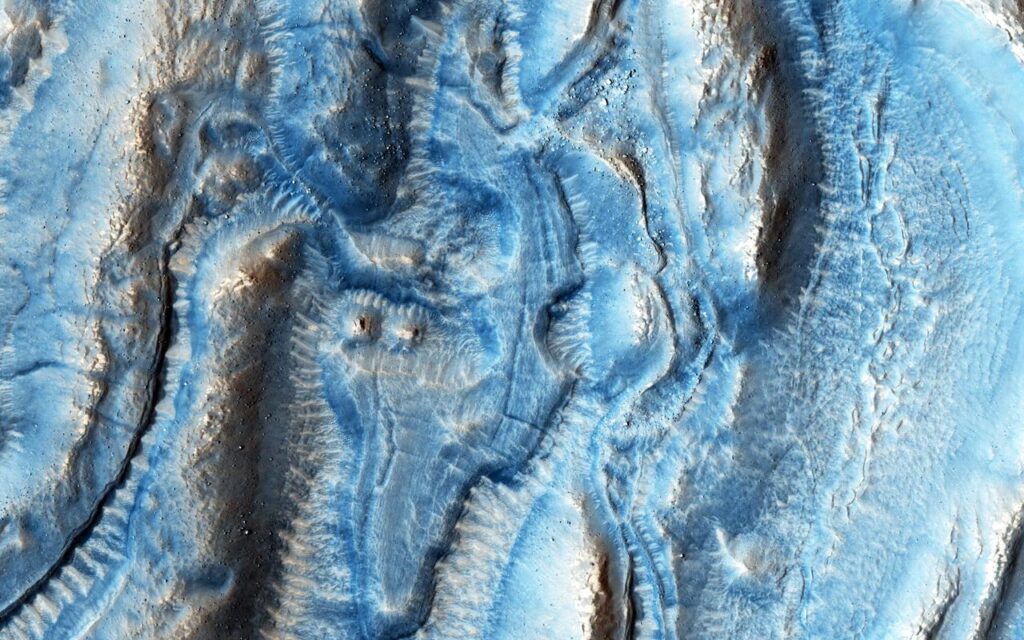
Yesterday, we talked a lot about climate change and retreating glaciers here on Earth. But Earth isn’t the only planet in our solar system that has had glaciers – Mars did, too. And while the cycle of advance and retreat of our glaciers and ice sheets has left the Earth’s surface scarred with valleys and fjords, the same is not similarly true for the red planet. That difference had scientists thinking that glaciers on Mars didn’t move.
Now, however, new research published in Geophysical Research Letters and led by Anna Grau Galofre presents evidence that the glaciers on Mars did move – just really, really slowly. And the difference is due to the smaller feedback loop from Mars’ lower gravity.
On Earth, the weight of the glaciers and ice sheets causes pressure and friction with the surface underneath. As the glaciers move, they melt on the bottom, forming channels of water that flow out from underneath the ice and essentially lubricate the downhill slope. This lubrication increases the flow rate of the glacier. With a much lower gravity – about 40% less strong than Earth’s – ice on Mars doesn’t have the same amount of friction against the surface. The effect is that Mars has different marks from its ice as a result. Grau Galofre explains: Whereas on Earth you would get drumlins, lineations, scouring marks, and moraines, on Mars you would tend to get channels and esker ridges under an ice sheet of exactly the same characteristics.
Additionally, the models show that Mars actually drained off the icy meltwater more efficiently than Earth did, which added to the lack of subglacial lubrication. This more efficient drainage could also have led to better conditions for life on Mars – protected from solar radiation in those subglacial lakes and insulated from temperature changes.
Now we need more rock samples from Jezero crater if we want to find evidence of that ancient life.
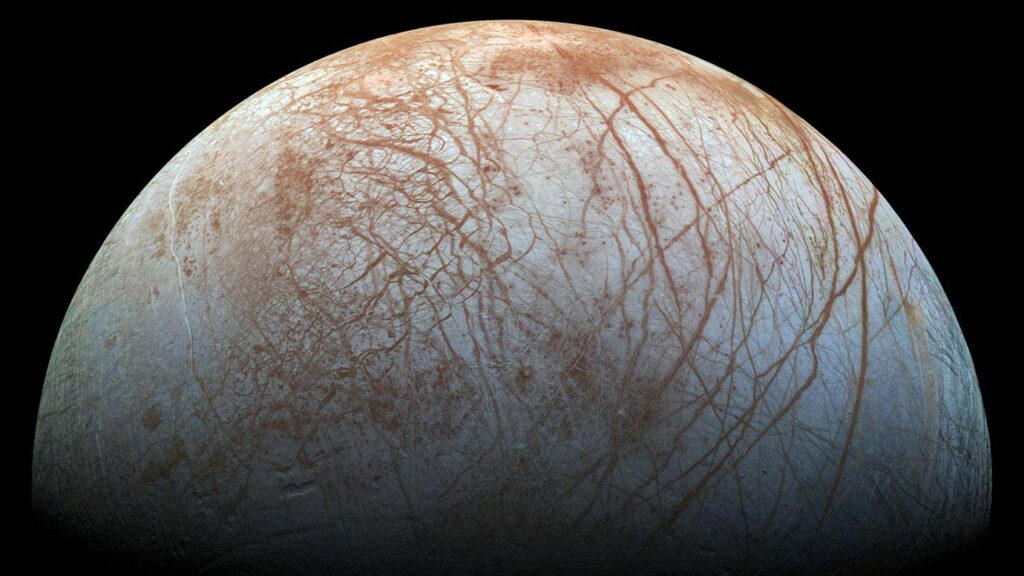
While Mars is just one other world in our solar system that once had water – and still may have water underground – it’s not the only world with subsurface water. We’ve also found gravitational and magnetic evidence for subsurface water on a host of icy moons and dwarf planets, including Ganymede, Europa, Enceladus, and even Ceres and Pluto. Those discoveries alone have upped the possibility of exoplanetary worlds rich in water as well, and new research published in Science and led by Rafael Luque finds that we might even be looking for evidence of water on those exoplanets using the wrong hypothesis.
The team of researchers analyzed a population of planets found orbiting stars called M dwarfs or red dwarfs; they’re incredibly common stars, and we now have an extensive catalog of exoplanets in those types of systems. Since we cannot see the exoplanets themselves due to the relative brightness of their stars and their close-in orbits, we have to use the transit method to catch the dips in the light and the radial velocity method to calculate the gravitational tugs on the star. Co-author Enric Pallé explains: The two different ways to discover planets each give you different information. By catching the shadow created when a planet crosses in front of its star, scientists can find the diameter of the planet. By measuring the tiny gravitational pull that a planet exerts on a star, scientists can find its mass.
Combine those two measurements and you can get the approximate density of the exoplanets. And when the team analyzed all these measurements from 43 different but similar exoplanets, they saw a pattern: densities that suggested the worlds were too light to be made entirely of rock. Which led to the conclusion that many of these worlds could be half-rock and half-water, or something similarly less dense.
If you think about how close these planets are to their stars, only having water under the surface makes sense. The surface temperatures would still be too hot for water to easily stay liquid, instead becoming supercritical gases that puff up the radius of the planets. And the radius measurements we have don’t match what we expected.
Once again, time for JWST to stare at some exoplanets and get us more detailed data.

This last planetary story has it all – a silly headline, a tortured backronym, and some literal thievery. First, the headline refers to this thievery as a ‘planetary heist’, and I’m still picturing a team of scientists a la Ocean’s Eleven planning to move a planet to another solar system. In reality, the thefts occur when star systems are younger and close together in stellar nurseries. More massive stars tend to capture the planets of smaller stars.
These captured planets are called ‘BEASTies’ by the research team, which is where the backronym comes in. The study in question is called the B-star Exoplanet Abundance STudy… or BEAST. Hence the ‘BEASTies’ name. Friendly reminder: astronomers are terrible at naming things.
The BEASTies are Jupiter-like planets that are orbiting their massive stepparent stars at huge distances… on the order of hundreds of times the distance between the Sun and Earth. Their formation was a mystery because the massive stars involved tend to have far too much ultraviolet radiation to allow planets to grow that big. Co-author Emma Daffern-Powell notes: We used computer simulations to show that the theft or capture of these BEASTies occurs on average once in the first 10 million years of the evolution of a star-forming region.
Yet one more way that planetary systems can evolve over time.
This research was published in the Monthly Notices of the Royal Astronomical Societywith lead author Richard Parker.
Coming up next, Erik Madaus tells us about several significant moments in U.S. space policy.
This Week in Space History

One of the things we realized last season is that we focused too much on satellites and launches in the history segment and ended up talking about eleventy billion slightly different space shuttle missions. There’s a lot more space history to cover. This week’s segment of This Week in Space History will be about significant presidential space policy speeches, and future segments will feature important people and significant events.
An example of “significant space policy speeches” is President Kennedy’s “we choose to go to the Moon” speech, which happened this coming week in 1962.
On September 12, 1962, at Rice University near Houston, Texas, President Kennedy informed the public at large that the United States was finally going to win the Space Race by putting a man on the Moon. This was right at the highest point of the Cold War when the U.S. and the Soviet Union were aiming nuclear weapons at each other and waiting for the other side to blink in the Cuban Missile Crisis. The Space Race was a less violent way for the two nations to compete, though the origins of satellite launch began with the very same missiles, just lacking nuclear warheads.
Both the United States and the Soviet Union came up with novel ways to one-up each other: first to orbit, first to fly by another planet, etc. The ultimate goal, at least from the U.S.’s perspective, was to land a human on the Moon and return him to Earth. (As a reminder, the first American woman wouldn’t go to space until 1983.) Up until that point, the Soviets had been the first to hit most major milestones. President Kennedy’s ambitious goal gave Americans something positive to look forward to, instead of the potentially apocalyptic conflict.
While the most important topic of President Kennedy’s speech was the lunar program announcement, he also had to win over the American people. Much of the framing of the speech talks about humanity’s history of exploration and science, and how America specifically contributed to it. He also addressed criticism of the proposal, since you couldn’t get away from people complaining about the cost of the space program and how it would benefit them even when it was a pure Cold War propaganda machine.
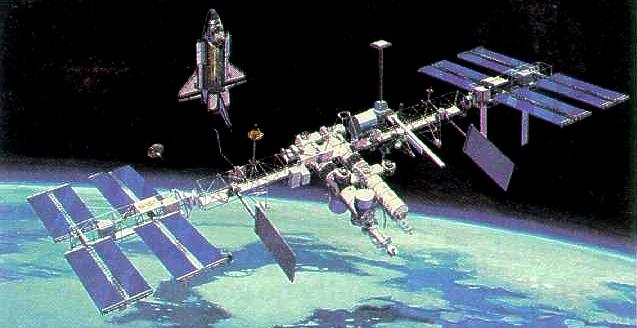
The quote “we choose to go to the moon and do the other things not because they are easy but because they are hard…” is what the speech is best remembered for. After Kennedy was assassinated a year later, the program was given new importance and successfully completed just in time for his deadline with the landing of Apollo 11 on July 20, 1969.
Kennedy wasn’t the only president to make space policy a major part of his administration. Several others did as well and announced their programs with speeches, such as George H. W. Bush on July 20, 1989.
President Bush Sr. presented his Space Exploration Initiative to the nation, a program where NASA would build a space station in Earth orbit, send humans back to the Moon in a more permanent fashion, and from there go on to Mars. Sound like Artemis? Sadly, nearly the entire program was canceled in 1993 because of cost. The space station, originally called Freedom, only survived because of its incorporation into the ISS program with Russia and others after the fall of the Soviet Union in 1991.
The next major presidential space policy speech was given by President George W. Bush (Bush 43) on January 14, 2004. President Bush Jr announced the Vision for Space Exploration. The Constellation program, NASA’s implementation of this policy, planned to return humans to the Moon as a stepping stone to Mars, using shuttle-derived rockets called Ares I and V.
Constellation was canceled in 2009 by Barack Obama but not really. The same contracts and everything were kept, turning what the design had morphed into at the very end of the Constellation program into the modern Space Launch System. That rocket, after a long development program, is currently sitting on the pad at 39B under a different name, Artemis.

Perhaps the most significant space policy speech was given by a Vice President, not the sitting president. On March 26, 2019, during a meeting of the National Space Council, Vice President Pence formally announced the Artemis program with the goal of putting the “first woman and next man” on the Moon in 2024 — much earlier than the previous goal of 2028. The Artemis program would use the existing SLS rocket and Orion spacecraft first conceived of in the Constellation program. The difference between this attempt and all the others that came before was designed sustainability. Artemis would have a space station in orbit of the Moon to allow repeated landings and longer stays in lunar orbit. Artemis also involves commercial companies in several aspects, from cargo resupply of the space station to the crewed lander itself.
Statistics
And now, for some statistics.
The number of toilets in space is eight: four on the ISS, one on Soyuz MS-21, one on the Crew Dragon Freedom, one on Tianhe, and one on Shenzhou 14.
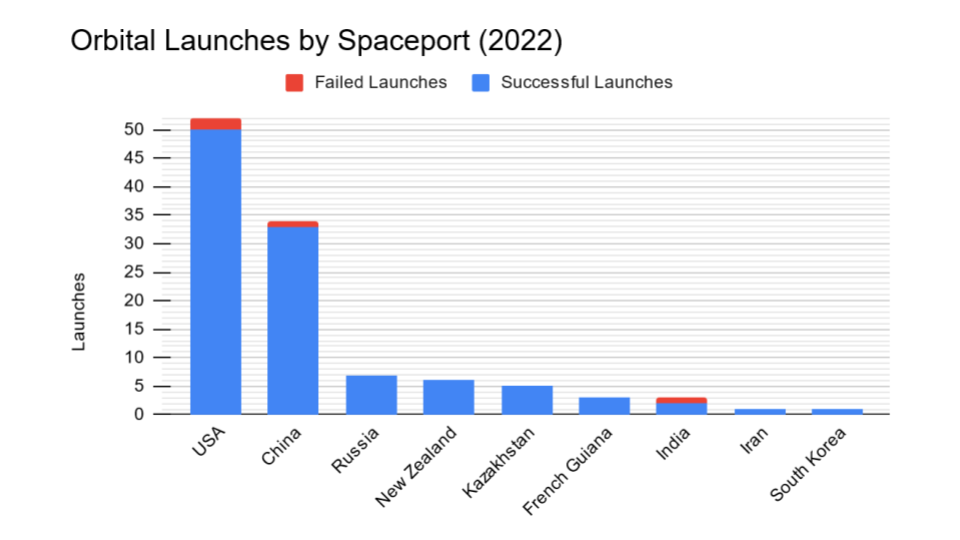
We keep track of orbital launches by launch site, also called spaceport. Here’s that breakdown:
USA: 52
China: 34
Russia: 7
New Zealand: 6
Kazakhstan: 5
French Guiana: 3
India: 3
Iran: 1
South Korea: 1
From those 112 launches, a total of 1,736 spacecraft have been put into orbit in 2022, with 1315 of them being Starlinks. That is about seven out of every ten satellites launched so far this year. There have also been fourteen humans sent to orbit this year onboard four launches. Since our last count, there have been four more spacewalks: three from the ISS and the fourth from the Tiangong space station’s new airlock on the Wentian module.
Your random space fact for this week is that the Moon is receding from the Earth at a rate of 4 centimeters per year. Eventually, it will move far enough away that total solar eclipses are no longer possible.
This has been the Daily Space.
You can find more information on all our stories, including images, at DailySpace.org. As always, we’re here thanks to the donations of people like you. If you like our content, please consider joining our Patreon at Patreon.com/CosmoQuestX.
Credits
Written by Pamela Gay, Annie Wilson, Beth Johnson, Erik Madaus, and Gordon Dewis
Hosted by Pamela Gay, Beth Johnson, and Erik Madaus
Audio and Video Editing by Ally Pelphrey
Content Editing by Beth Johnson
Intro and Outro music by Kevin MacLeod, https://incompetech.com/music/


 We record most shows live, on Twitch. Follow us today to get alerts when we go live.
We record most shows live, on Twitch. Follow us today to get alerts when we go live.